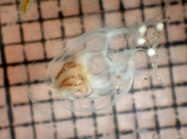RAS taxon details
Calycopsis Fewkes, 1882
117028 (urn:lsid:marinespecies.org:taxname:117028)
accepted
Genus
Calycopsis typa Fewkes, 1882 (type by monotypy)
- Species Calycopsis borchgrevinki (Browne, 1910)
- Species Calycopsis typa Fewkes, 1882
marine, terrestrial
Fewkes, J. W. (1882). On the Acalephae of the East coast of New-England. <em>Bulletin of the Museum of comparative Zoölogy of Harvard College.</em> 9: 291-310, pl. 1., available online at https://www.biodiversitylibrary.org/page/30291435
page(s): 304 [details]
page(s): 304 [details]
Schuchert, P.; Choong, H.; Galea, H.; Hoeksema, B.; Lindsay, D.; Manko, M.; Pica, D. (2025). World Hydrozoa Database. Calycopsis Fewkes, 1882. Accessed through: RAS (Eds.) (2025) Register of Antarctic Species at: https://ras.biodiversity.aq/aphia.php?p=taxdetails&id=117028 on 2025-09-13
RAS (Eds.) (2025). Register of Antarctic Species. Calycopsis Fewkes, 1882. Accessed at: https://ras.biodiversity.aq/aphia.php?p=taxdetails&id=117028 on 2025-09-13
Date
action
by
2006-09-07 06:51:43Z
changed
Martinez, Olga
original description
Fewkes, J. W. (1882). On the Acalephae of the East coast of New-England. <em>Bulletin of the Museum of comparative Zoölogy of Harvard College.</em> 9: 291-310, pl. 1., available online at https://www.biodiversitylibrary.org/page/30291435
page(s): 304 [details]
basis of record van der Land, J.; Vervoort, W.; Cairns, S.D.; Schuchert, P. (2001). Hydrozoa, <B><I>in</I></B>: Costello, M.J. <i>et al.</i> (Ed.) (2001). <i>European register of marine species: a check-list of the marine species in Europe and a bibliography of guides to their identification. Collection Patrimoines Naturels,</i> 50: pp. 112-120 (look up in IMIS) [details]
additional source Neave, Sheffield Airey. (1939-1996). Nomenclator Zoologicus vol. 1-10 Online. <em>[Online Nomenclator Zoologicus at Checklistbank. Ubio link has gone].</em> , available online at https://www.checklistbank.org/dataset/126539/about [details]
additional source Schuchert, P. (2009). The European athecate hydroids and their medusae (Hydrozoa, Cnidaria): Filifera Part 5. <em>Revue Suisse de Zoologie.</em> 116: 441-507., available online at https://doi.org/10.5962/bhl.part.117779 [details]
page(s): 304 [details]
basis of record van der Land, J.; Vervoort, W.; Cairns, S.D.; Schuchert, P. (2001). Hydrozoa, <B><I>in</I></B>: Costello, M.J. <i>et al.</i> (Ed.) (2001). <i>European register of marine species: a check-list of the marine species in Europe and a bibliography of guides to their identification. Collection Patrimoines Naturels,</i> 50: pp. 112-120 (look up in IMIS) [details]
additional source Neave, Sheffield Airey. (1939-1996). Nomenclator Zoologicus vol. 1-10 Online. <em>[Online Nomenclator Zoologicus at Checklistbank. Ubio link has gone].</em> , available online at https://www.checklistbank.org/dataset/126539/about [details]
additional source Schuchert, P. (2009). The European athecate hydroids and their medusae (Hydrozoa, Cnidaria): Filifera Part 5. <em>Revue Suisse de Zoologie.</em> 116: 441-507., available online at https://doi.org/10.5962/bhl.part.117779 [details]
 Present
Present  Inaccurate
Inaccurate  Introduced: alien
Introduced: alien  Containing type locality
Containing type locality

